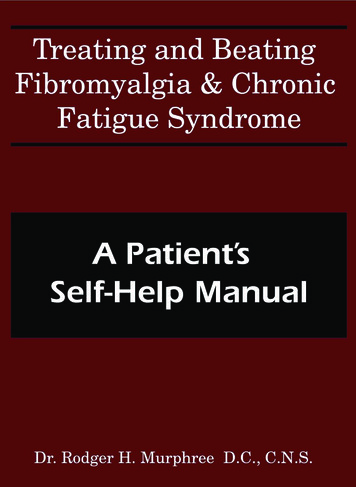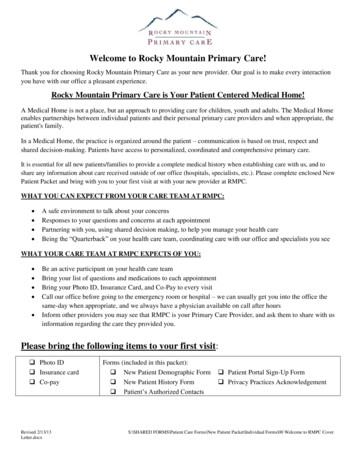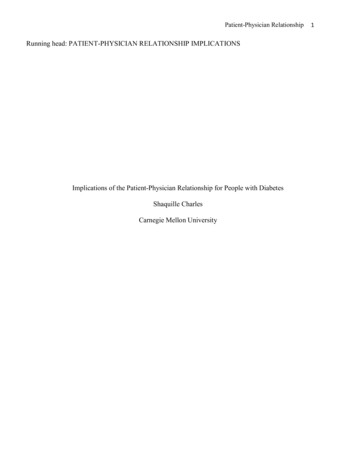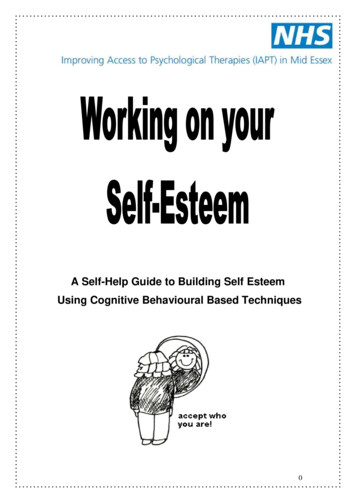
Transcription
A Patient’sSelf-Help Manual
Many manufacturers and sellers claim trademarks on their unique products.When these trademarks appear in this book and we are aware of them, wehave used initial capital letters (e.g., Prozac) for designation.Endnotes designated in the text of this book can be found at the end of eachcorresponding chapter. Patient testimonials are based on actual experiences asobserved by the author. Patient names have been changed to protect privacy.Copyright 2005 by Rodger H. Murphree IIAll rights reserved. No part of this publication may be reproduced, stored in aretrieval system, or transmitted, in any form or by any means—electronic,mechanical, photocopying, recording, or otherwise—without the prior writtenpermission of the author (except where noted otherwise).Printed in the United States of America.Harrison and Hampton Publishing, Inc.825 Conroy Road, Birmingham, AL 35222Editing and book design by Lori BuchananContact Information:Dr. Rodger Murphree3401 Independence Dr. Suite 121Birmingham, AL, 35209Phone: (205) 879-2383 orToll-free: 1-888-884-9577Fax: (205) 879-2381Email: DrRodgerM@yahoo.comVisit us at www.DrRodger.com .This book and the advice given are not intended to take the place of yourphysician’s. I recommend all patients consult with a medical doctor beforediscontinuing any prescription medication.
Table of Contents Introduction.1–6Chapter 1: Fibromyalgia Syndrome.7–12Chapter 2: Chronic Fatigue Syndrome.13–18Chapter 3: Looking for Clues.19–42Chapter 4: Convential Medical Therapies.43–74Chapter 5: Sleep Disorders.75–102Chapter 6: Adrenal Fatigue.103–122Chapter 7: Digestion and GI Disorders.123–144Chapter 8: Immune System Dysfunction.145–158Chapter 9: Chronic Pain and Inflammation.159–178Chapter 10: Food Allergies.179–192Chapter 11: Thyroid Dysfunction.193–204
ivChapter 12: Mood Disorders.205–228Chapter 13: Yeast Overgrowth.229–240Chapter 14: Liver Detoxification.241–246Chapter 15: First Days Instruction Sheet.247–256Chapter 16: Follow-up Procedures.257–260Appendix.A-1 thru A-44
Introduction This manual is designed to be a companion to my book,Treating and Beating Fibromyalgia and Chronic FatigueSyndrome. My purpose in writing this manual is to provide youwith a step-by-step approach for beating your illness. To get themost out of this manual, I strongly recommend that you read mybook, Treating and Beating Fibromyalgia and Chronic FatigueSyndrome.A New Kind of MedicineWhen I first began practicing fourteen years ago, I'd never heard ofFibromyalgia or Chronic Fatigue Syndrome. Fibromyalgia wasnever mentioned in any of the medical textbooks we used in ourstudies. Then, eight years ago, a patient was referred to me whochanged my life forever. She was suffering from a strange collection of symptoms: diffuse pain throughout her body, headaches,menstrual irregularities, allergies, chronic infections, insomnia,depression, digestive problems, and unrelenting fatigue. Afterseveral years of being passed from one doctor to the next, shehad recently been diagnosed with Fibromyalgia by a localrheumatologist.Though medications had been recommended to her, theywere mostly for covering up the various symptoms she was
2A Step-by-step How-to Guideexperiencing. A friend told her about me and how I had helped herovercome chronic headaches. Mrs. Jones* had turned to me indesperation. Her Fibromyalgia symptoms were getting worse andno one seemed to be able to help her.I read everything I could find on Fibromyalgia Syndrome (FMS)and Chronic Fatigue Syndrome (CFS). Fortunately, I was notaware that there was “no cure” for Fibromyalgia. I just did what Ihad been doing with all of my patients. I treated the whole personfrom the inside out.Three months later, Sheila was totally well. She no longer hadpain, insomnia, fatigue, allergies, or any of the other symptomsthat had plagued her. She was ecstatic, and so was I. I quicklybegan to get dozens of Fibromyalgia and Chronic FatigueSyndrome patients. I continued to learn, refine, and update myFibromyalgia and Chronic Fatigue Syndrome treatment protocol.Some patients got well. Some did not. Although I was happy withmy successes, I was more disturbed about the failures. Why didsome patients get well while others did not? I continued to searchfor answers. I found other chiropractors, nutritionists, massagetherapists, and medical doctors who were also searching foranswers. It became clear to me that I had to think “outside thebox” to effectively treat Fibromyalgia and CFS. These illnesses donot come with a neatly packaged set of symptoms that fit into aninsurance code book. They demand a new way of thinking.I decided I would open my own medical practice. This practicewas based on integrating prescription and natural therapies*This individual’s name has been changed for the purpose of confidentiality.
Introduction(integrative medicine) for the prevention and treatment of disease.I learned a great deal about integrating traditional and alternativemethods. I learned firsthand how prescription medications couldprovide relief for many common illnesses. Some prescription medications were tremendously helpful, including natural Bio-identicalhormones (tri-estrogen and progesterone cream), Armour thyroid,T3 therapy, low-dose Cortef, proper sleep medications (only after5HTP, melatonin, or other naturals didn’t work), antibiotics foracute bacterial infections, and cortisone for acute back pain andrespiratory infections.Unfortunately, I also learned that medications have side effectsand don’t always work. A majority of our patients were medicalmisfits who had already been to dozens of doctors and weretherefore on a variety of prescription medications. Many of thesemedications were more harmful than helpful. I eventually realizedthat prescription medication didn’t offer much hope for thesemedical misfits. I knew that correcting the person’s biochemistrywas the key to restoring a person’s inborn healing mechanisms.Prescription medications could, in some cases, be helpful, butthey could never be better than our own self-regulating, God-givenhealing mechanisms. The medical practice continued to grow, andwe moved onto the campus of a major hospital in Birmingham,Alabama. Red tape, insurance demands, and an ever-increasingfinancial overhead started to affect how we practiced. Eventually,we became so overwhelmed with patients that we fell back intothe conventional medical paradigm of 10–15 minute office visitsending with more prescriptions (either nutritional or medical).Patients were now on dozens of supplements and prescriptionmedications for a variety of symptoms. We had lost some of theoriginal ideas that prompted me to start the medical practice.3
4A Step-by-step How-to GuideI sold my interest in the medical practice and, with great trepidation, opened my own one-man practice once again. How was Igoing to continue to see patients with complicated illnesses (something I feel called to do) without the aid of prescription medications? I would soon find that nutritional medicine can and doeshold its own when paired against chronic illnesses.I found, through trial and error, that the less I referred to my oldmedical clinic, the better many of my fibromyalgia patients did.The reasons were many, but mainly because the fewer medications the patient was on, the easier it was to restore her own selfhealing mechanisms. This doesn’t mean I don’t refer to medicaldoctors. I often do. But now that I’ve been on both sides of thefence (conventional medicine and nutritional medicine), I knowthat the type of nutritional medicine I practice works! Even if conventional medicine continues to say it doesn’t.I had come full circle. I now know that the way to feel better (andget well), was to get healthy from the inside out. So I wrote a bookall about why nutritional medicine works, Treating and BeatingFibromyalgia and Chronic Fatigue Syndrome.Patients now call, email, or travel from all over the world to consult with me. Why? Because my program works! These “medicalmisfits” have usually been to dozens of medical doctors, includingthose at Mayo and John Hopkins. Yet, conventional medicine hasfailed them. But some little chiropractic nutritionist inBirmingham, Alabama, is able to help them!There is no doubt that conventional medicine saves thousandsof lives each year. Conventional medicine excels at life-saving
Introductiontreatments. It is often effective in alleviating many of the symptoms associated with certain illnesses. However, no one is bornwith a Prozac deficiency, and treating symptoms doesn’t translateinto better health. Conventional medical therapies often attemptto mop the wet kitchen floor (symptom) while ignoring the leakyroof (cause).The way to beat FMS and CFS is to get healthy. This manual isdesigned to help you uncover the nutritional or biochemical disorders that are making you sick. Once you start repairing thesedisorders (correcting the cause[s]), miracles can happen. You canget your life back. You can feel good again!I hope you find that this manual and its approach will help youget well, just as it has helped thousands of patients aroundthe world.5
6A Step-by-step How-to Guide
Chapter 1Fibromyalgia SyndromeI don’t treat illnesses. I treat people! Nomatter the illness, most individuals will getwell by concentrating on getting healthy fromthe inside out, correcting causes, and notmerely covering up symptoms.– Dr. Rodger H. Murphree, D.C., C.N.S.Fibromyalgia (FMS) is characterized by diffuse muscle pain,poor sleep, and unrelenting fatigue. Other symptoms includepoor memory, depression, irritable bowel, chemical sensitivities,allergies, chronic infections, and headaches. Leading FMSresearchers estimate that 2–4% of the general population sufferfrom this syndrome. Ninety percent of those diagnosed with FMSare women. The stiffness and pain associated with FMS usuallyappear gradually and become worse, with additional physical,emotional, and/or mental fatigue. The soft tissue and muscles ofthe neck, shoulders, chest and rib cage, lower back, and thighsare especially vulnerable. This pain can be mild and annoying, orsevere and disabling.FMS shares some of the symptoms of chronic fatigue syndrome(CFS). In fact, 70% of patients diagnosed with FMS also meet allof the diagnostic criteria for CFS.
8A Step-by-step How-to GuideDIAGNOSTIC CRITERIAFORFIBROMYALGIA(These criteria were first proposed in 1990 by the American College of Rheumatology.)1. History of Widespread PainPain is considered widespread when all of the following arepresent: pain in the left side of the body, pain in the right sideof the body, pain above the waist, and pain below the waist.In addition, axial skeletal pain (cervical spine, anterior chest,thoracic spine, or low back) must be present. In this definition,shoulder and buttock pain is considered as pain for eachinvolved side. Low back pain is considered lower segment pain.2. Pain in 11 of 18 Tender Point Sites on Digital Palpation1Diagnoses have been missed because many individuals withFMS meet some of the criteria but not all of them. Most ofthese individuals have other symptoms associated with FMSnot explicitly outlined in the ACR criteria. They might haveinsomnia, irritable bowel, fatigue, mental confusion, and onlyfour of the 18 tender points. Or they might have insomnia,fatigue, and five reproducible tender points. Although theminor criteria represent the most frequent and usualsymptoms associated with FMS, they don’t account for allof the various conditions seen in FMS patients.The symptoms of FMS and CFS don’t fit neatly into a medical howto book. This frustrates many doctors, but it doesn’t matter to mewhether or not patients have 18 reproducible trigger points. If theyhave trouble sleeping (falling asleep within 30 minutes and sleepingthrough the night) and have chronic pain, then they either haveFMS or they’re at high risk for developing the illness.
POTENTIAL SYMPTOMSChapter 1: FibromyalgiaOFFMS Sleep disturbances: Sufferers might not feel refresheddespite getting adequate amounts of sleep. They might alsohave difficulty falling or staying asleep. Stiffness: Body stiffness is present in most patients. Weatherchanges and remaining in one position for a long period oftime contribute to the problem. Stiffness might also bepresent upon awakening. Headaches and facial pain: Headaches may be caused byassociated tenderness in the neck and shoulder area or inthe soft tissue around the temporomandibular joint (TMJ). Abdominal discomfort: Irritable bowel syndrome, with suchsymptoms as digestive disturbances, abdominal pain andbloating, constipation, and diarrhea, might be present. Irritable bladder: Patients might have an increase in urinaryfrequency and a greater urgency to urinate. Numbness (parathesia): Symptoms include a prickling,tingling, or burning sensation in the extremities. Chest pain: Muscular pain at the point where the ribs meetthe chest bone might occur. Cognitive disorders: The symptoms of cognitive disordersmay vary from day to day. They can include “spaciness,”memory lapses, difficulty concentrating, word mix-upswhen speaking or writing, and clumsiness. Chemical (environmental) sensitivity: Sensitivities to light,noise, odor, and weather are often present, as are allergicreactions to a variety of substances. Disequilibrium: Difficulties in orientation may occur whenstanding, driving, or reading. Dizziness and balanceproblems might also be present.9
10A Step-by-step How-to GuideA SAMPLEOF1,000 FMS PATIENTSCarol Jessop, MD, reports that a sample of close to 1,000 ofher FMS patients shows that they suffer or suffered from thefollowing: 2 muscular pain (100%)poor sleep and fatigue (nearly 100%)depression (nearly 100%)cold hands and feet with poor circulation, known asRaynaud’s syndrome (40%)anxiety (24%)elevated temperature (10%)low temperature, suggesting low thyroid and metabolism(65%)low blood pressure, suggesting dysautonomia and pooradrenal function (86%)white spots on their nails, suggesting low zinc and poordigestion or malabsorption (85%)tender thyroid (40%)swollen lymph nodes, suggesting an immune dysfunction(18%).irritable bowel syndrome (73%)severe headaches, usually associated with low magnesiumand low thyroid and adrenal hormones (50%)dry eyes, suggestive of allergies (18%)osteoarthritis (12%)rheumatoid arthritis (7%)yeast in the stool (82%)parasites in the stool (30%)
Chapter 1: Fibromyalgia irregular periods, suggestive of poor nutrition (60%) TMJ syndrome (25%) endometriosis, suggestive of estrogen dominance and/or liverdysfunction (15%) restless leg syndrome, suggestive of low magnesium (30%) multiple chemical sensitivities, suggestive of liver dysfunction(40%) interstitial cystitis (25%) irritable bladder (15%) mitral valve prolapse (75%)Just as interesting are the symptoms her patients had beforedeveloping FMS: constipation (58%)bloating, gas, and/or indigestion (80%)heartburn (40%)irritable bowel syndrome (89%)Recommended Reading Treating and Beating Fibromyalgia and Chronic Fatigue Syndromeby RH Murphree, DC, CNS; 2003.Resources You are invited to visit my website, www.DrRodger.com . American College of Rheumatology’s website,www.Rheumatology.org .NOTES1. American College of Rheumatology website, June 2004.2. From author’s notes: Fibromyalgia Workshop. Speaker: Leon Chaitow, 2000.11
12A Step-by-step How-to Guide
Chapter 2Chronic Fatigue SyndromeChronic Fatigue Syndrome (CFS) shares many similarities withFMS. Several studies have suggested that they are the sameillness. One study comparing 50 CFS patients with 50 FMSpatients showed the following symptoms to be the same for bothgroups: low-grade fever (28%), swollen lymph nodes (33%), rash(47%), cough (40%), and recurrent sore throat (54%). Anotherstudy comparing CFS patients with FMS patients showed thatbrain wave patterns, tender points, pain, and fatigue were virtually identical in both groups.1A 1997 study by Allen N. Tyler, MD, ND, DC, muddies the watereven further. Ten patients, all of whom met the ACR criteria forFMS, were selected at random for blood testing. They were testedfor influenza type-B antibodies, and three of the ten testedpositive. Another randomly selected group of ten FMS patients(meeting all the ACR criteria) were tested for antibodies toinfluenza type-A. Nine of them tested positive.2
14A Step-by-step How-to GuideDIAGNOSTIC CRITERIAFORCHRONIC FATIGUE SYNDROME3Major Criteria1. new onset of fatigue causing 50% reduction in activity for atleast six months2. exclusion of other illnesses that can cause fatigueMinor Criteria1. presence of eight of 11 symptoms, or2. presence of six of 11 symptoms and two of three signs:SYMPTOMS1. mild fever2. recurrent sore throat3. painful lymph nodes4. muscle weakness5. muscle pain6. migratory joint pain7. prolonged fatigue after exercise8. recurrent headaches9. neurological or psychological complaints, such as: depression excessive irritability forgetfulness sensitivity to bright light confusion inability to concentrate10. sleep disturbances11. sudden onset of symptom complex
Chapter 2: Chronic Fatigue SyndromeSIGNS1. low-grade fever2. non-exudative pharyngitis (sore throat)3. tender lymph nodesDue to weakened immunity, individuals with chronic fatigue haveterrible problems with energy as well as recurring bouts with theflu, colds, sinusitis, and other immune problems. As with so manycomplex chronic illnesses, CFS may be aggravated by a wide variety of environmental and physiological challenges. Food allergies,environmental sensitivities (odors), heavy metal toxicity (mercury,aluminum, etc.), yeast overgrowth, parasites, and vitamin/mineraldeficiencies can all contribute to CFS.All of us have been exposed to mono or the Epstein-Barr virus(or other viruses) at one time or another (usually as teenagers),but our bodies are usually strong enough to overcome theexposure. We develop immunity to the virus. We carry the virusaround inside of us until we die. Normally, this dormant virusnever causes any more problems. It is kept in check by a healthyimmune system.Individuals with CFS aren’t able to squelch the normally dormantvirus (or other bug), and it begins to raise its ugly head onceagain. Individuals with CFS may feel like they are walking aroundwith the “flu from hell.” They have all the symptoms of a very badcase of the flu. But unlike most cases of the flu, CFS doesn’tdisappear after one or two weeks.15
16A Step-by-step How-to GuideHOWTOQUICKLY DISTINGUISH BETWEEN FMSANDCFSA positive EBV panel is a clear indicator that someone has CFS.However, you don’t need a blood test to diagnose CFS. If you havechronic fatigue (hard to get out of bed each day), achy diffusepain, and a lowered immune function (chronic infections), thenyou either have CFS or you’re at high risk of developing it.The CFS patient usually has chronic infections (sinusitis, upperrespiratory, urinary tract infections colds, flu, etc.) and is sick several times a year. She gets at least two bad infections a year. Theywill usually have chronic or intermittent sore throats, swollenlymph nodes, and periodic fevers. They usually ache all over. FMSpatients may ache all over as well, but they usually have specificareas (neck, low back, etc.) that are the most troublesome.Many CFS patients will also have a sluggish liver (more likely thanin those with FMS). Clues that would lead you to suspect a sluggish liver include funny or negative reactions to medications (theytake something to put them to sleep, and it wakes them up, or “alittle goes a long way”); intolerance to caffeine, alcohol, or odors(the longer they’ve had the illness, the more sensitive they becometo odors, perfumes, gasoline, smoke, cleaners, etc.); and a historyof elevated liver enzymes on past blood work. Of course, anyonewith hepatitis or fatty liver has a sluggish liver. Long-term prescription-medication therapies can also create a sluggish liver.
CFSChapter 2: Chronic Fatigue SyndromeANDLIVER DYSFUNCTIONCFS patients are more likely than FMS patients to have a sluggishliver. Clues that would lead you to suspect you may have a sluggish liver include: chemical sensitivities (see below) funny or negative reactions to medications (you takesomething to put you to sleep but it wakes you up, or a littlegoes a long way) intolerance of caffeine intolerance of alcohol intolerance of odors (the longer patients have had the illness,the more sensitive they become to odors, perfumes, gasoline,smoke, cleaners, etc.) a history of elevated liver enzymes on past blood work.CFS patients may have severe chemical sensitivities and may notbe able to tolerate nutritional supplements. They may have allergicreactions to even the purest multivitamins. This complicatesthings. It is best to start slow, especially with individuals whohave severe chemical sensitivities.Further InformationPlease see Chapter 14, Liver Dysfunction.Please see Chapter 8, Immune System Dysfunction, for the ImmuneFunction Protocol.17
18A Step-by-step How-to GuideRecommended Reading Treating and Beating Fibromyalgia and Chronic Fatigue Syndromeby RH Murphree, DC, CNS; 2003. From Fatigued to Fantastic by Jacob Teitelbaum, MD.NOTES1. J Rheum 1992 and CIBA Foundation Symposium, 173.2. Altern Med Rev, 1997.3. Centers for Disease Control.
Chapter 3Looking for CluesOkay. It's time to put your detective caps on. As you readthrough this chapter, look for clues that are intended to helpyou solve your health problems. The following questionnaire is thesame one I use in my practice. You don't have to physically fill itout. However, I strongly recommend you read all the way throughthe questionnaire and take notes as you go. Then, at the end ofthe questionnaire, use your notes to help direct you to the chapters you should focus on. Happy hunting.FIBROMYALGIA AND CHRONIC FATIGUENEW PATIENT INTAKE FORM(WITHCOMMENTS IN ITALICS)NOTE: THIS FORM APPEARS WITHOUT COMMENTS IN THE APPENDIXWhat medications are you taking? Please list them here:Most CFS/FMS patients are on at least six prescription medications.These medications may cause all sorts of side-effects: anti-depressants can cause anxiety; benzodiazepines (anxiety medications likeXanax or Klonpin) can cause amnesia and depression; NSAIDs(Celebrex, Alleve, Mobic, etc.) can cause intestinal permeability;
20A Step-by-step How-to Guidecholesterol medications (Lipitor, Zocor, and others) can cause diffusemuscle pain; etc. There are dozens of prescription medications thatwill make your CFS/FMS worse.Specific medications and their side effects are discussed in detail inChapter 4, Conventional Medical Therapies.Do you have trouble falling asleep? Yes NoDo you have trouble staying asleep? Yes NoWhen did you first start having trouble sleeping (months, years ago)?These are perhaps the three most important questions on this intakeform. If a person is having problems with sleep (can’t fall asleepand stay asleep without medication) and has diffuse pain, it is agood bet that she has FMS.If she does consistently sleep through the night without medications(or naturals) but complains that she just doesn’t have any energy,gets sick a lot, and has achy pain, she most likely has CFS ( a person can have both illnesses).These are important clues. Both illnesses are treated with highdoses of nutritional supplements. However, I’m always relieved tosee that patients have checked that they are having trouble withtheir sleep. I know if I can get them going into deep sleep (and Iusually can) and build up their serotonin levels (with 5HTP), theseindividuals will feel better in only a couple of weeks. I find that theclassic symptoms associated with FMS—insomnia, depression,pain, fatigue, anxiety, and irritable bowel syndrome (IBS)—respondquickly to restored serotonin levels.
Chapter 3: Looking for CluesIt takes longer and is harder to get these same results in true CFSpatient. I define a true CFS patient as having a severely compromised immune system and having normal serotonin levels. Theseindividuals usually have a sluggish liver (indicated by funny reactions to medications, odor aversions, and chemical sensitivities),catch every cold or flu that comes around, suffer from chronic infections, and have zero tolerance to stress. But they don’t have anytrouble sleeping.An in-depth discussion on sleep concerns is covered in chapter 5,Sleep Disorders.What over-the-counter or prescription medications have you takenfor sleep?AmbienZanaflexTrazadoneNeurontinTylenol aXanaxAtivanIf you’re on sleep medications, I suspect you have a serotonin deficiency. Some of these drugs promote deep, restorative sleep (the keyto getting well) and some don’t. Those in bold promote deep,restorative sleep. Those in regular type, don’t. All of these medications have potential unwanted side effects. These side effects couldbe making your condition worse.If you’re taking any of the above medications, then please readabout them in chapter 4, Conventional Medical Therapies, andchapter 5, Sleep Disorders.21
22A Step-by-step How-to GuideNEUROTRANSMITTERS/MOOD DISORDERS(BRAIN CHEMICALS)Are you taking one or more antidepressants? Yes NoIf so, please list them here:Have you taken other antidepressants in the past?Yes NoIf so, which ones? ProzacPaxilCelexaLexaprEffexorZoloftWellbutrinWere they helpful? Please describe in detail (didn’t help, hadside-effects, stopped working, etc.):Do you crave carbohydrates, starches, and/or sugar?Yes NoA positive answer suggests a serotonin deficiency. This may alsopoint to a yeast overgrowth problem. The amino acid tryptophan(5HTP) is best absorbed when combined with carbohydrates(sugar). Sugar or starches act as sedatives. This may be whypeople under stress attempt to self medicate through over eating(especially starches). Sugar feeds yeast, and those with a yeastovergrowth will often have sugar cravings.
Chapter 3: Looking for CluesDo you get white spots on your fingernails? Yes No Not sureWhite spots on the nails are a sign of a zinc deficiency. A zinc deficiency leads to elevated copper levels. Excess copper can createanxiety, nervousness, insomnia, and fatigue. Long-term elevatedcopper levels lead to depression.For a thorough discussion on vitamins, minerals, amino acids, andessential fatty acids, please see my book, Treating and BeatingFibromyalgia and Chronic Fatigue Syndrome.For further information on medical therapies and mood disorders,see chapters 4 and 12.BOWEL FUNCTIONDo you have normal, daily bowel movements (at least one bowelmovement a day)? Yes NoDo you have loose bowels (diarrhea), constipation, or perhaps both?Please describe:If a patient is constipated, it usually means he is deficient in magnesium. Once he starts taking 600–700 mg of magnesium, normalbowel function will return. The CFS/Fibromyalgia Formula has 700mg of magnesium.Have you been diagnosed with Irritable Bowel Syndrome (IBS)?Yes No23
24A Step-by-step How-to GuideIBS usually goes away after one to two weeks on my program.There are more serotonin receptors in the intestinal tract than in thebrain! Serotonin helps control the speed at which food is brokendown and moved through the intestinal tract. A serotonin deficiencycauses IBS. Restoring normal serotonin levels with 5HTP usuallycures IBS once and for all.Do you ever have floating stools (floats on top of toilet water)?Yes NoFloating stools are a sign that a person is not breaking down thefats in her diet. She might have problems with her gallbladder (orno gallbladder). This person should take pancreatic digestiveenzymes or bile salts with each meal.Specific information regarding bowel function is discussed in chapter 7, Digestion and GI Disorders.IMMUNE FUNCTIONCheck all that apply to you:Chronic Sinus CongestionChronic Sinus Infections (2 or more a year)Chronic Sore ThroatChronic Colds or Flu infections each yearChronic Upper Respiratory Infections (Bronchitis, Pneumonia)Chronic means a minimum of 3–4 times a year.These items will be checked by true CFS patients. Those with FMSmay also have chronic infections. Chronic sinusitis is a common
Chapter 3: Looking for Cluescomplaint seen in those with CFS and FMS. I always suspect a lowthyroid if someone suffers from chronic sinus infections.For further information, please see chapter 8, Immune SystemDisorders.LIVER FUNCTIONHave you ever had elevated (high) liver enzymes on laboratory bloodwork? Yes No Not SureA “yes” could possibly mean a sluggish liver, usually from takingprescription medications. It could also be due to a fatty liver orhepatitis.Do you have any funny reactions when you drink alcohol (a little goesa long way, can’t drink red wine, etc.)? If so, please describe:A positive answer suggests you may have a sluggish liver.Do you have any problems eating raw onions? YesNoRaw onion can cause problems in individuals with a sluggish liver.The sulphur in raw onions is the culprit.The day after eating asparagus, do you get a very strong odor whenurinating?YesNo25
26A Step-by-step
Treating and Beating Fibromyalgia and Chronic Fatigue Syndrome. My purpose in writing this manual is to provide you with a step-by-step approach for beating your illness. To get the most out of this manual, I strongly recommend that you read my book, Treating and Beating Fibromyalgia and Chronic Fatigue Syndrome. A New Kind of Medicine











